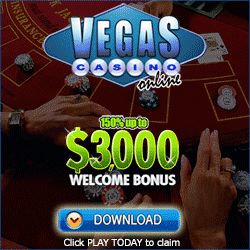Roulette is a popular game of chance which has grown to become an absolute mainstay in brick-and-mortar gambling venues the world over. The game continues to flourish in the 21st century as nowadays, it is easily accessible in a broad range of online casinos where it is possible to make a pick between an imposing number of variants, each one with its own peculiarities and table limits.
The secret behind the success of roulette is quite simple as this is one of the easiest casino games to play in terms of rules and betting structure. What further contributes to roulette’s appeal is its wild diversity of betting choices. The level of excitement and dynamics it offers is tough to match, which explains the crowds of players flocking to the roulette tables in hopes of their lucky number being spun.
Roulette Rules and Objective
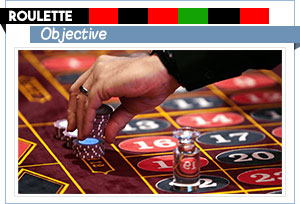 If you are making your first steps towards playing roulette for real money, the proper way to start is by learning what the game is all about. Luckily for you, the rules of this game of chance are rather straightforward, so you are unlikely to experience any difficulties even if you lack any previous experience.
If you are making your first steps towards playing roulette for real money, the proper way to start is by learning what the game is all about. Luckily for you, the rules of this game of chance are rather straightforward, so you are unlikely to experience any difficulties even if you lack any previous experience.
In roulette, the object of each player is to make a correct guess as to which numbered pocket the white ball will land on. Similarly to the majority of other casinos games, roulette is played against the house and players are not actually competing against each other. Generally, there are 37 or 38 pockets, depending on the variant you play. These contain numbers 0 through 36, but in double-zero games there is an additional 00 pocket.
Since this is a game of chance, one of its principal characteristics is that it is subject to the law of independent trials. In other words, there is no way for players to know the result and plan ahead what bets to make in order to correctly predict the outcome of the toss. Therefore, each toss of the ball is an independent event by itself and as such, it is not affected by preceding spins and does not impact the outcomes of subsequent tosses, either. The likelihood of each number coming up is exactly the same as that of the remaining numbers. Randomness is precisely what makes roulette so exciting – you never know when you are going to pocket a nice payout.
At the beginning of each round, the dealer announces “Place your bets” and when players have positioned their chips in the corresponding betting boxes on the layout, the ball is tossed in a direction which is opposite to that of the spinning wheel.
One of the greatest peculiarities that will strike you at the roulette table are the chips themselves since they are unlike those used in other casino games like blackjack, poker, and baccarat. Here each participant gets chips of a different color, which is to prevent mix-ups of the bets on the layout. If a player has already placed their chips on the number you want to bet, you can neatly stack your chips on top of theirs – the dealer will differentiate which chips belong to whom by their color.
In roulette, it is possible to make more than one bet on any given spin. It is strictly forbidden to place chips on the layout after the ball has fallen onto the wheel-head and the dealer has announced “No more bets”. If you do this, your bet would most certainly not be accepted.
Once the white ball settles into a pocket, the dealer would place a marker on the winning number, clear the losing bets off the layout, and pay out the winners depending on the type of bets they have made. While there are no written rules to state you should tip your dealer in landbased casinos, this would be the courteous thing to do, especially if you are in the middle of a hot streak. Once all bets are settled and the outcome of the last spin is resolved, another betting round can begin.
Special Rules in European and French Roulette
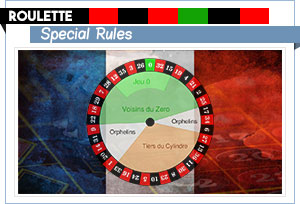 The European and French variants of the game are played on a single-zero wheel where there is only one green zero pocket. In some games, players are granted a second chance to win with their even-money bets if the ball comes to a halt in the green zero pocket. Normally, bets on number properties like Red/Black, Odd/Even, and High/Low hit frequently with a payout of 1 to 1, but are automatic losers if the winning number is 0.
The European and French variants of the game are played on a single-zero wheel where there is only one green zero pocket. In some games, players are granted a second chance to win with their even-money bets if the ball comes to a halt in the green zero pocket. Normally, bets on number properties like Red/Black, Odd/Even, and High/Low hit frequently with a payout of 1 to 1, but are automatic losers if the winning number is 0.
Luckily for players, there are special rules at some single-zero tables which apply specifically to those even-money wagers. The advantage of playing at such tables is that they offer a reduced house edge to the benefit of the players. One of these rules is called En Prison (“in prison”) and it gives players an opportunity to recover their even-money stakes after the zero is spun. The stake remains on the losing even-money bet for the next spin and if the player wins the second time around, they get their original stake back.
Another special rule to be found at many single-zero tables is the La Partage which translates as “sharing”. Whenever zero hits, the player is not allowed to let their losing even-money stake ride but loses only half of the bet amount, instead. The reduction of the house edge with both rules coincides – the house holds an advantage of 1.35% over players when En Prison or La Partage apply.
While La Partage and En Prison are valid predominantly in single-zero games, there is a rare special rule which is said to reduce the edge in double-zero roulette variants almost in half. This is known as “Surrender” and is to be found predominantly at the roulette tables in Atlantic City. It is basically the same as La Partage as it is enforced whenever 0 or 00 win, in which case the player “surrenders” half of their original stake and retains the rest. This leads to a reduction in the house edge from 5.26% to 2.63% for all even-money bets.
The Roulette Table – The Layout, The Wheel and The Racetrack
Prior to joining a roulette game, be it in an online or a landbased casino, players need to familiarize themselves with the specifics of the roulette table equipment. We can differentiate between two types of roulette wheels, the first one being the so-called French wheel which contains 37 divisions or pockets. One of those is colored in green and contains the single zero, while the remaining pockets are colored in alternating black and red and contain numbers 1 through 36.
The zero is normally positioned between pockets 26 and 32. The numbers on the wheel are ordered in a seemingly chaotic sequence so as to ensure the randomness of results. Odd and even numbers are somewhat evenly distributed on the wheel as each odd number is normally followed by at least one even number. Note that the zero is considered neither odd, nor even.
American wheels are frequently referred to as double-zero wheels because they contain one additional green zero pocket, 00, which makes for a total of 38 divisions on the wheel-head. The double zero is also added on the table’s layout. The number sequence around the wheel-heads of American wheels differs greatly from the sequence used on their French cousins.
The two zero pockets are normally positioned opposite one another but the same applies to all other numbers on the wheel. There is no need to look closely to notice that number 1 is diagonally opposite to number 2, 13 is opposite to 14, and so on. Since the number sequences differ, it is impossible to “announce” certain types of bets on double-zero wheels but we will touch upon those in further detail later on.
For the most part, the layouts of double-zero and single-zero tables coincide, the chief difference being there is one additional betting box to accommodate the 00 on the American tables. There is a peripheral section where Outside bets are placed. The main betting grid contains individual boxes for each number represented on the wheel.
In French variations of the game, the bet types are listed in French on the layout. Some European variants are played on a double-ended table. The wheel is positioned in the center and is surrounded by two layouts on each side. Each of the two “mirror” layouts is operated by a separate dealer.
In single-zero games where the number sequence of the wheel allows for Announced bets, there is a separate section of the layout where the chips for those are placed. This furthers the convenience of players and dealers as Announced bets normally cover way too many numbers of the wheel for you to place chips on each one on the main number grid. This section is called a “racetrack” because this is precisely what it looks like. The sequence of numbers on the racetrack coincides with that on the single-zero wheel.
Bets to Make in Roulette
Roulette is a dynamic, yet simplified game but what further adds to its appeal are the versatile betting options players get to choose from. Some types of bets are riskier than others but compensate with heftier payouts. Others win more frequently but offer a rather humble return on winning bets. At the end of the day, the bet choices you make should depend solely on your bankroll size and the type of player you are – bold or more averse to the risks this brilliant game entails. The roulette bets can be grouped into the three major categories we have listed below.
Outside Bets
With outside bets, players are basically wagering on the properties of the numbers. These are the bets which offer the best odds in roulette but their payouts are normally far from impressive. Players can choose to bet on Red/Black or Odd/Even numbers. Since the zero is neither odd, nor even, it is excluded from outside bets and causes them to lose when it hits.
Therefore, there are 36 numbers which qualify for outside bets and these can be grouped into two categories – low, with numbers 1 through 18 and high, consisting of numbers 19 through 36. High/Low bets win when the number the ball lands on is within the player’s chosen range. All outside bets on number properties like red/black, high/low and odd/even return even money.
Column bets cover all 12 numbers in the player’s vertical column of choice, for instance, 3, 6, 9, 12, 15, 18, 21, 24, 27, 30, 33, and 36. There are three such columns in the main betting grid where all the individual numbers are represented. Another less risky outside bet is the Dozen bet which covers 12 numbers from one of the three dozens on the layout – the 1st Dozen contains 1 through 12, the 2nd Dozen consists of numbers 13 through 24, and the 3rd Dozen spans numbers 25 through 36. Both the Dozen and the Column bet return at a rate of 2 to 1.
Inside Bets
Bets that fall into this group are made on individual numbers or on entire sections of numbers. Straight Up bets cover only one out of 37 numbers and boast the highest return in roulette, 35 to 1.
Split bets cover only two numbers that are horizontally or vertically adjacent on the layout, like 20 and 23 or 14 and 13. The return on winning Split bets is 17 to 1.
Street bets pay out at a rate of 11 to 1 and cover sequences of three numbers in a horizontal line, like 22, 23, and 24.
Another type of inside bet is the Corner bet where players are wagering on four adjacent numbers which meet in one corner of the layout. An example of a Corner bet would be 6, 5, 8 and 9 and the return is 8 to 1.
Line bets pay out 5 to 1 and involve six numbers that are part of two horizontal lines on the layout, like 4, 5, 6, 7, 8, and 9.
It is also possible to make a Basket bet which covers four specific numbers, namely 0, 1, 2 and 3, with a payout ratio of 6 to 1.
In double-zero games, there is a variation of the Basket bet which is called a Five-Number bet since it covers pockets 0, 00, 1, 2, and 3. The payouts coincide but this wager is to be avoided like the plague on double-zero wheels because it is anything but profitable. The probability of winning with one such stake is only 13.15%, while the house edge reaches the shocking 7.90%.
Announced or Call Bets
Call bets hold a special place in roulette because unlike other wagers in the game, they cover entire sections of the wheel consisting of chaotic, yet adjacent numbers. These can be placed only in single-zero games thanks to the unique sequence in which the numbers are ordered on the wheel.
Call bets are sometimes mistakenly referred to as “Announced” bets, but there is an important distinction between the two. With Call bets, casino patrons are practically gambling on credit as they simply call out what bet they wish to make without placing any chips on the table to cover their stake. Because of this, Call bets are not accepted in many casinos around the world.
Announced bets coincide with Call bets, only the player announces the wager they want to make and places the chips on the table to cover it before the ball settles in a pocket to determine the outcome of the spin.
We can distinguish between several types of wagers that fall into the group of Call or Announced bets. Neighbors of Zero (Voisins du Zero) covers the 17 numbers positioned between 22 and 25 on the wheel, including 22 and 25. In order to make one such bet, the player needs at least nine chips. Tiers du Cylindre covers one-third of the wheel’s numbers, namely those that lie between 27 and 33, included. Since the bet involves twelve numbers, it requires six chips and each one is placed on one of the six splits.
The Orphans, or Orphelins in French, are all the numbers left out of the Tiers and the Neighbors categories. These are located within two separate sections of the wheel. The first one consists of 17, 34, and 6 while the second one comprises numbers 1, 20, 14, 31, and 9. The Orphelins bet requires five chips or more to make four Splits and one Straight bet.
Single-zero games offer a unique announced bet, called a Final bet since it involves players betting on all numbers ending in the same digit. An example of a Final bet would be a wager made on numbers 4, 14, 24, and 34. In some variants, it is allowed to make a Zero Game bet (also known as Jeu Zero in French and Zero Spiel in German). It covers the numbers that are located in close proximity to the zero on the wheel, which for the most part coincide with the numbers included in the Neighbors of Zero bet, but the chips are placed differently on the layout.
Minimum and Maximum Bet Limits in Roulette
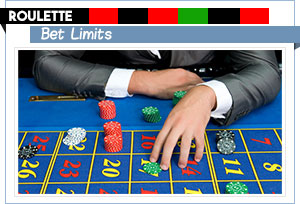 Similarly to all other casino games, roulette players are expected to stay within the minimum and maximum limits of the table. These are normally stated on a small plaque. However, bet limits in roulette work in a different way than those in card games like blackjack and baccarat, for instance.
Similarly to all other casino games, roulette players are expected to stay within the minimum and maximum limits of the table. These are normally stated on a small plaque. However, bet limits in roulette work in a different way than those in card games like blackjack and baccarat, for instance.
You may notice that there are distinct limits for inside and outside bets, which do not necessarily coincide with the minimum and the maximum limits set for the table. The inside maximum designates how much players are allowed to stake on Straight Up bets, made on individual numbers. Often there are different maximums for Split, Street, and Corner bets which typically increase proportionately. So if the maximum for a single Straight bet is $10, the limits for Split, Street and Corner bets would be $20, $30, and $40, respectively.
The maximum on Straight bets is much lower because winning wagers of this type offer a massive return to players. Meanwhile, the outside maximum indicates how much players can put on stake when making even-money bets on Red/Black or High/Low, for example. The maximum for Outside bets normally coincides with the upper table limit or is around half of the table maximum. It all depends on the roulette variant you have chosen.
Let’s assume the maximum for even-money outside bets is $200. Since this limit applies to each individual even-money bet, it would be possible to make several of those as long as you fit within the table limit. In this case, you would be allowed to bet $200 on Red and another $200 on Even, if the outside maximum is set at $500. The table minimums for outside and inside bets often coincide.
Roulette Odds, Probabilities and House Edge
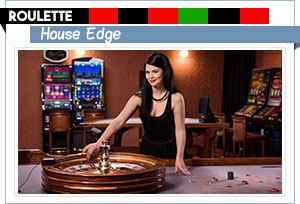 Since roulette is based on independent trials, it is impossible to predict the outcome of each round with an absolute certainty. Nevertheless, players can calculate how likely it is for any given bet to win by using the concept of probability. Then, they can evaluate whether or not the bet is worth making on the basis of its return and the probability of winning with it.
Since roulette is based on independent trials, it is impossible to predict the outcome of each round with an absolute certainty. Nevertheless, players can calculate how likely it is for any given bet to win by using the concept of probability. Then, they can evaluate whether or not the bet is worth making on the basis of its return and the probability of winning with it.
The terms probability and odds are sometimes used interchangeably but this is not necessarily correct. Probability is normally expressed in percentages or fractions and it represents the likelihood of a given event happening. Probability is easy to calculate in roulette as one simply needs to divide the number of ways to win by the total number of outcomes. For example, a Corner bet covers 4 numbers out of 37 possible outcomes on a single-zero wheel. Therefore, its probability is calculated in the following manner: 4/37 = 0.10810 x 100 = 10.81%.
Meanwhile, the term “odds” denotes the number of ways to win as opposed to the number of ways to lose. We can express the odds of winning a roulette bet either as a ratio or as a vulgar fraction, in which case the numerator stands for the ways to win while the denominator shows the number of ways to lose. To proceed with the above example, the odds of collecting a return with a Corner bet would be 4 to 34 or 4/34.
You may notice there is a small discrepancy in the true odds of winning with a roulette bet and the odds casino pays you at. This is precisely what gives the house its edge. The house always holds an advantage over its patrons due to the fact it pays out winning wagers at reduced odds which do not necessarily coincide with the mathematical probability of winning with a given type of bet.
The house edge refers to the average amount of money the casino collects over the long run on all wagers it accepts, both winning and losing ones. In roulette, the house gets its edge from the presence of the green zero pocket in the wheel. If it was not for the zero, players would have greater chances of winning with both their inside and outside bets.
However, when it comes to payouts, the house refuses to acknowledge the existence of the green zero pocket and offers a return which would be fair if there were only 36 pockets on the wheel. Therefore, a Straight Up bet returns at a rate of 35 to 1, despite the fact the odds of losing with it are higher at 36 to 1 and 37 to 1 on double-zero wheels. These discrepancies are to be found in the payouts for all types of bets in roulette and in casino games, in general. The single zero lends the house an edge of 2.70% in European roulette while the additional double zero almost doubles the casino’s advantage in American roulette to 5.26%.
| Type of Bet | Winning Spaces | Payout | Odds against Winning |
|---|---|---|---|
| Straight up | Any single number including 0 | 35 to 1 | 36 to 1 |
| Split | Any two adjoining numbers | 17 to 1 | 18 to 1 |
| Basket | 0,1,2 or 0,2,3 | 11 to 1 | 11.33 to 1 |
| Street | Any three numbers horizontal | 11 to 1 | 11.33 to 1 |
| Corner | Any four adjoining numbers | 8 to 1 | 8.25 to 1 |
| Six Line | Any six numbers from two rows | 5 to 1 | 5.167 to 1 |
| 1st Column | 1,4,7,10,13,16,19,22,25,28,31,34 | 2 to 1 | 2.083 to 1 |
| 2nd Column | 2,5,8,11,14,17,20,23,26,29,32,35 | 2 to 1 | 2.083 to 1 |
| 3rd Column | 3,6,9,12,15,18,21,24,27,30,33,36 | 2 to 1 | 2.083 to 1 |
| 1st Dozen | 1 through 12 | 2 to 1 | 2.083 to 1 |
| 2nd Dozen | 13 through 24 | 2 to 1 | 2.083 to 1 |
| 3rd Dozen | 25 through 36 | 2 to 1 | 2.083 to 1 |
| Odd | 1,3,5,7…33,35 | 1 to 1 | 1.056 to 1 |
| Even | 2,4,6,8…34,36 | 1 to 1 | 1.056 to 1 |
| Red | Any Red | 1 to 1 | 1.056 to 1 |
| Black | Any Black | 1 to 1 | 1.056 to 1 |
| 1 to 18 | 1,2,3,4…18 | 1 to 1 | 1.056 to 1 |
| 19 to 36 | 19,20,21,22…36 | 1 to 1 | 1.056 to 1 |
Misconceptions to Avoid when Playing Roulette
Roulette is the most enigmatic game to be found on casino floors worldwide and as such, it is riddled with superstitions and misconceptions. One such misconception is believing any given number is “due” because the ball has not landed upon it for a very long time. Such numbers also go by the name of “sleepers”. Call it what you will, but in games of sheer chance, nothing is ever due to happen since neither the wheel, nor the ball have memory. The chances of each number coming up are equal and there is no mathematically sound explanation to justify the above-mentioned line of reasoning.
Another misconception that practically mirrors the idea of “due” numbers is the false notion that a specific number or number property is “on a streak”. Thus, a superstitious player would notice Red has hit three times in a row, for example, and would quickly bet on this color for the next spin because Red is currently on a hot streak. There is no logical reason to justify one such bet. In roulette, each outcome should be treated separately as it bears absolutely no relation to previous or succeeding results.
Then again, there are players who would resort to the opposite approach in the same situation because they, too, assume that there are trends they can trust in this game. Therefore, they would bet on Black because Red had come up two or three consecutive times, assuming the ball would stop in a black pocket for a change. This assumption is just as nonsensical as betting on your date of birth repeatedly because it “brings you luck”.
One thing players need to remember is that in roulette, there is no such thing as lucky or due numbers. Sure, everything is based on chance, but the only way to increase your odds of emerging a winner is to use common sense and implement adequate bankroll management into your betting sessions.
- American Roulette
- Best Real-Money Roulette Sites
- Best Roulette Systems
- Double Action Roulette
- Double Ball Roulette
- European Roulette
- French Roulette
- High Roller Roulette
- Most Popular Roulette Games
- Phenomenal Live Roulette (Luckystreak)
- Play Roulette Online
- Progressive Jackpot Roulette
- Roulette Bets and Betting Patterns
- Roulette Odds and Probabilities
- Roulette Strategies
- Roulette Variations
- Ultimate Roulette (Ezugi) Means Extreme Casino Fun








